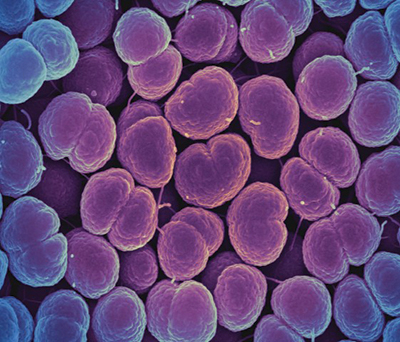MCP: Researchers closer to gonorrhea vaccine after exhaustive analysis of proteins
In a study of drug-resistant gonorrhea strains historic in its scope, researchers at Oregon State University have pushed closer to a vaccine for gonorrhea and toward understanding why the bacteria that cause the disease are so good at fending off antimicrobial drugs.
 Neisseria gonorrhoeae, the bacterium that causes gonorrhea, is shown here in a scanning electron micrograph.NIAID
Neisseria gonorrhoeae, the bacterium that causes gonorrhea, is shown here in a scanning electron micrograph.NIAID
, published in the journal Â鶹´«Ã½É«ÇéƬ & Cellular Proteomics, are especially important since the microbe Neisseria gonorrhoeae is considered a “superbug” because of its resistance to all classes of antibiotics available for treating infections.
Gonorrhea, a sexually transmitted disease that results in 78 million new cases worldwide each year, is highly damaging if untreated or improperly treated. It can lead to endometritis, pelvic inflammatory disease, ectopic pregnancy, epididymitis and infertility.
Babies born to infected mothers are at increased risk of blindness. Up to 50 percent of infected women don’t show any symptoms, but those asymptomatic cases still can lead to severe consequences for the patient’s reproductive health, miscarriage or premature delivery.
, a researcher with the OSU College of Pharmacy and Oregon Health and Science University’s Vaccine and Gene Therapy Institute, helped lead an international collaboration that performed proteomic profiling on 15 gonococcal strains.
Among the isolates in the study were the reference strains maintained by the World Health Organization that show all known profiles of gonococcal antimicrobial resistance.
For each strain, researchers divided the proteins into those found on the cell envelope and those in the cytoplasm. More than 1,600 proteins — 904 from the cell envelopes and 723 from the cytoplasm — were found to be common among all 15 strains, and from those, nine new potential vaccine candidates were identified.
A vaccine works by introducing an “invader” protein known as an antigen that triggers the body’s immune system and subsequently helps it quickly recognize and attack the organism that produced the antigen.
Researchers also found six new proteins that were expressed distinctively in all of the strains, suggesting they’re markers for or play roles in drug resistance and thus might be effective targets for new antimicrobials.
In addition, scientists looked at the connection between bacterial phenotype — the microbes’ observable characteristics and behavior — and the resistance signatures that studying the proteins revealed; they found seven matching phenotype clusters between already-known signatures and the ones uncovered by proteomic analysis.
Together, the findings represent a key step toward new weapons in the fight against a relentless and ever-evolving pathogen.
“We created a reference proteomics databank for researchers looking at gonococcal vaccines and also antimicrobial resistance,” said Sikora, co-corresponding author on the study. “This was the first such large-scale proteomic survey to identify new vaccine candidates and potential resistance signatures. It’s very exciting.”
The findings add new momentum to a vaccine quest that also received a boost in summer 2017, when showed that patients receiving the outer membrane vesicle meningococcal B vaccine to prevent Neisseria meningitis were 30 percent less likely to contract gonorrhea than those who didn’t get the vaccine.
“All previous vaccine trials had failed,” Sikora said.
Gonorrhea and meningococcal meningitis have different means of transmission, and they cause different problems in the body, but their source pathogens are close genetic relatives.
This article is republished from the website.
Enjoy reading ASBMB Today?
Become a member to receive the print edition four times a year and the digital edition monthly.
Learn moreGet the latest from ASBMB Today
Enter your email address, and we’ll send you a weekly email with recent articles, interviews and more.
Latest in Science
Science highlights or most popular articles

ApoA1 reduce atherosclerotic plaques via cell death pathway
Researchers show that ApoA1, a key HDL protein, helps reduce plaque and necrotic core formation in atherosclerosis by modulating Bim-driven macrophage death. The findings reveal new insights into how ApoA1 protects against heart disease.

Omega-3 lowers inflammation, blood pressure in obese adults
A randomized study shows omega-3 supplements reduce proinflammatory chemokines and lower blood pressure in obese adults, furthering the understanding of how to modulate cardiovascular disease risk.

AI unlocks the hidden grammar of gene regulation
Using fruit flies and artificial intelligence, Julia Zeitlinger’s lab is decoding genome patterns — revealing how transcription factors and nucleosomes control gene expression, pushing biology toward faster, more precise discoveries.

Zebrafish model links low omega-3s to eye abnormalities
Researchers at the University of Colorado Anschutz developed a zebrafish model to show that low maternal docosahexaenoic acid can disrupt embryo eye development and immune gene expression, offering a tool to study nutrition in neurodevelopment.

Top reviewers at ASBMB journals
Editors recognize the heavy-lifters and rising stars during Peer Review Week.

Teaching AI to listen
A computational medicine graduate student reflects on building natural language processing tools that extract meaning from messy clinical notes — transforming how we identify genetic risk while redefining what it means to listen in science.

